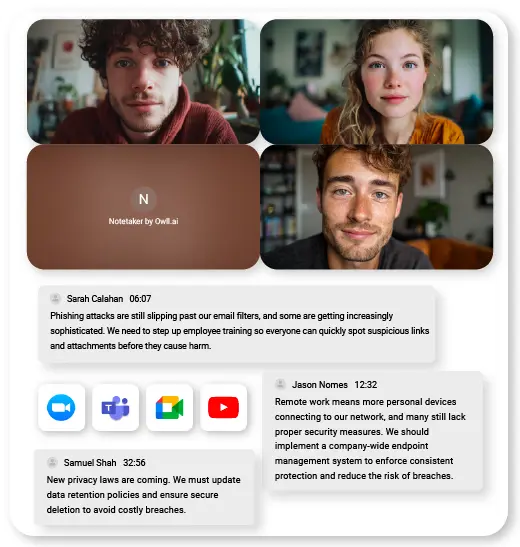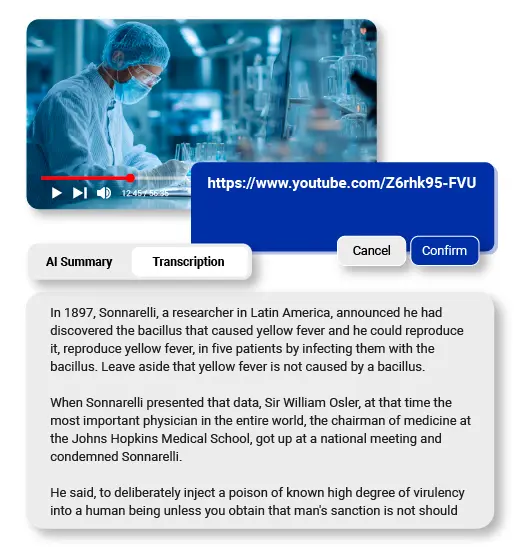How to Transcribe Videos Using AI Tools for Notes

If you’ve ever spent hours rewinding lecture videos to catch every detail or frantically scribbling notes while a professor races through complex concepts, you’re not alone. Students worldwide lose countless hours to manual video note-taking, often missing key points in the process. With educational content exploding across YouTube—from crash courses to in-depth tutorials—the information overload has become overwhelming. Traditional note-taking methods simply can’t keep pace with the volume of video content required for modern learning. AI YouTube video summarizers offer a transformative solution to this challenge. These intelligent tools automatically transcribe spoken content, extract key concepts, and generate organized summaries in minutes rather than hours. By leveraging artificial intelligence to handle the mechanical work of transcription, students can focus their energy on understanding and applying knowledge instead of capturing it. The result? Dramatic time savings, improved comprehension through better-organized notes, and the ability to review material more efficiently during exam preparation.
The Student’s Video Note-Taking Struggle Explained
Manual video note-taking consumes precious study hours that could be spent on deeper learning. Students typically pause, rewind, and replay lecture videos multiple times just to capture complete sentences, turning a one-hour video into a three-hour transcription marathon. This repetitive process interrupts the natural flow of learning and fragments comprehension, making it difficult to grasp how concepts connect. Complex subjects like organic chemistry or advanced mathematics present additional challenges—when professors explain intricate processes, students must choose between understanding the material or writing it down, rarely achieving both simultaneously. Non-native English speakers face even steeper barriers, struggling to decode rapid speech, academic terminology, and unfamiliar accents while trying to keep pace with content delivery. These accessibility issues create unequal learning conditions where language proficiency becomes an unnecessary obstacle to subject mastery. AI YouTube video summarizers directly address these pain points by instantly converting spoken lectures into searchable text, allowing students to focus on comprehension rather than transcription mechanics, and providing equal access to content regardless of language background or listening speed preferences.
Understanding AI YouTube Video Summarizers
AI YouTube video summarizers combine two powerful technologies to transform spoken lectures into organized notes. Speech recognition algorithms first convert audio into text by analyzing sound patterns and matching them against vast linguistic databases, achieving accuracy rates exceeding 90% for clear academic content. Natural language processing then takes over, identifying key concepts, filtering filler words, and understanding context to distinguish important information from tangential remarks. These tools don’t simply transcribe every word—they analyze sentence structure, recognize topic transitions, and detect emphasis patterns to determine what matters most. The result is intelligent summarization that captures core ideas while eliminating redundant explanations. Interactive transcripts represent the most valuable output format, allowing students to click any text segment and jump directly to that moment in the video. This clickable functionality transforms passive watching into active learning, enabling quick navigation to confusing sections that need review or skipping ahead to specific topics within lengthy lectures, making study sessions dramatically more efficient than traditional linear playback.
Choosing the Right AI Transcription Tool
Critical Features Comparison
Accuracy rates vary dramatically between AI transcription tools, with academic-focused platforms achieving 95-98% precision on lecture content compared to 85-90% for general-purpose options. The difference becomes critical when transcribing technical terminology, mathematical expressions, or discipline-specific vocabulary that generic tools frequently misinterpret. Output format flexibility determines how easily you can integrate transcriptions into existing workflows—look for tools offering plain text for quick reference, SRT subtitle files for video annotation, and interactive transcripts that sync text with video timestamps. Video to text conversion speed matters during exam preparation periods when multiple lectures need processing simultaneously; premium tools typically handle hour-long videos in 3-5 minutes while free alternatives may require 15-20 minutes. Language support breadth proves essential for international students or those studying foreign language content, with top-tier platforms recognizing 50+ languages and dialects compared to basic tools limited to major languages.
Top AI Tools for Students
Freemium platforms like Otter.ai and Google’s Live Transcribe provide solid baseline transcription without upfront costs, ideal for students testing AI workflows before committing financially. These entry-level options typically impose monthly limits on transcription minutes but cover most undergraduate needs. Specialized academic tools offer advanced features like automatic citation generation, subject-specific vocabulary recognition, and direct integration with platforms like Notion, Evernote, and Google Docs where students already organize coursework. Browser extensions represent the most convenient category, adding transcription buttons directly to YouTube’s interface for one-click processing without switching between applications. Platforms like Owll AI have emerged to specifically address student needs with features designed for educational content processing. Consider tools offering offline capabilities if you study in locations with unreliable internet connectivity, ensuring consistent access to transcription functions regardless of network availability.
Step-by-Step: Transcribing YouTube Videos with AI
Begin by locating the video URL—right-click any YouTube video and select “Copy video URL” from the menu, or simply copy the address from your browser’s location bar. For videos in playlists, ensure you’re copying the individual video link rather than the playlist URL to avoid processing errors. Next, select an AI platform matching your specific needs: choose Otter.ai for real-time collaborative transcription during live streams, Descript for videos requiring heavy editing afterward, or browser extensions like Glasp for instant processing without leaving YouTube. Once you’ve pasted the URL into your chosen tool, customize processing parameters before starting—adjust language settings if the video contains non-English content, enable speaker identification for panel discussions or interviews with multiple voices, and select timestamp intervals (typically 30-second or 1-minute increments work best for academic lectures). After processing completes, refine the output by scanning for technical terms the AI may have misinterpreted, particularly discipline-specific vocabulary, proper nouns, or mathematical expressions. Use the search-and-replace function to correct recurring errors systematically rather than fixing each instance individually. Export your polished transcript in your preferred format—interactive HTML for clickable navigation, plain text for importing into note-taking apps, or SRT files if you plan to create custom subtitled versions of the video for future reference.
Creating Effective Summaries with AI Tools
Most AI platforms offer customizable summary settings that balance detail against brevity—configure these based on your purpose, selecting detailed mode for exam preparation that requires comprehensive coverage or concise mode for quick topic refreshers before class discussions. Adjust percentage-based compression ratios to control output length, with 25-30% compression ideal for preserving technical explanations while 10-15% works for overview purposes. Chapter-based summarization transforms lengthy multi-topic lectures into digestible segments by detecting natural transitions between subjects, allowing AI tools to generate separate summaries for each conceptual unit rather than blending everything into generic overviews. This segmentation proves invaluable for three-hour recorded seminars covering multiple case studies or historical periods, where distinct summaries enable targeted review of specific sections without processing irrelevant material. When you transcribe YouTube videos using these structured approaches, verify summary quality by cross-referencing key points against the original video at critical timestamps—spot-check technical definitions, numerical data, and conclusion statements where AI misinterpretation carries the highest risk. Compare AI-generated summaries against your own understanding of the material, flagging sections where the summary seems disconnected from the video’s actual emphasis or where important caveats and exceptions get omitted in the condensation process.
Integrating Transcripts into Study Workflows
Organize transcripts using a hierarchical folder system that mirrors your course structure—create main folders for each subject, subfolders for units or modules, and individual files named with lecture dates and topics for instant retrieval. Cloud-based platforms like Google Drive or Dropbox ensure access across devices, letting you reference transcripts whether studying at your desk or reviewing on mobile during commutes. Annotating interactive transcripts transforms passive text into active study materials by highlighting critical definitions in one color, exam-relevant examples in another, and confusing concepts requiring professor clarification in a third. Most AI tools support inline comments where you can add personal observations, connect ideas to textbook readings, or flag sections for group discussion. Combining AI-generated transcripts with handwritten or typed personal notes creates comprehensive study resources that capture both factual content and your interpretive understanding. Insert transcript excerpts directly into your main notes as supporting evidence, then add your own analysis explaining why concepts matter or how they connect to previous material. This hybrid approach leverages AI efficiency for capturing raw information while preserving the cognitive benefits of manual note-taking for deeper processing and retention.
Advanced Applications for Academic Success
Transform AI-generated summaries into flashcard decks by extracting key terms and their definitions directly from transcripts, then importing them into spaced repetition apps like Anki or Quizlet for optimized memorization scheduling. Most AI tools allow bulk export of highlighted sections, enabling rapid flashcard creation without manual typing. Collaborative study becomes seamless when sharing interactive transcripts with classmates through cloud platforms—multiple students can annotate the same document simultaneously, pooling their insights and clarifying confusing concepts through collective commentary. This shared approach distributes the cognitive load of processing lengthy lectures across study groups. For research projects, AI transcripts convert video interviews, documentary footage, and expert presentations into searchable text databases where you can locate specific quotes using keyword searches rather than scrubbing through hours of footage, dramatically accelerating literature reviews and source citation workflows.
Transform Your Video Learning with AI Transcription
AI-powered transcription tools fundamentally transform how students engage with video content, reclaiming hours previously lost to manual note-taking and endless rewinding. By automating the mechanical task of capturing spoken words, these intelligent platforms free your mental energy for what truly matters—understanding concepts, making connections, and applying knowledge to real-world problems. The shift from passive transcription to active learning represents more than mere convenience; it’s a strategic advantage that levels the playing field for students regardless of language background, learning speed, or note-taking proficiency. As educational content continues migrating to video formats across YouTube and other platforms, mastering AI summarization tools becomes essential rather than optional for academic success. Start with a single lecture this week—choose one lengthy video from your most challenging course and experience firsthand how AI transcription converts overwhelming content into manageable, searchable notes. The time you save on that first video will convince you more powerfully than any article ever could. Embrace these tools not as shortcuts that diminish learning, but as amplifiers that enhance your capacity to absorb, organize, and retain the exponentially growing body of knowledge your education demands.





